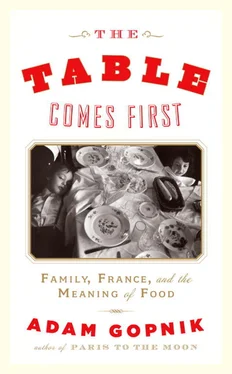Indeed, among the real La Reynière’s circle, a reactionary countermyth soon sprang up, romanticizing French food. Instead of being the work of métissage , mixed-up influences and urban crossbreedings, French cooking was said to be quite simply the cooking of the noble French peasant and the simple French provinces brought to the tables of the city. This attempt to make the cooking that had grown up in Paris look as though it had always been stewing in the same pious pot would have its bad effect on French cuisine.
The culinary historians who have written the new history of the restaurant are mostly what might be called “sizzlists.” They think the atmosphere, the sizzle, around the steak is more important to its aura than the steak itself. Most of the new culinary historians practice “niche” history, and, like the best of such books, theirs are rich in weird data, unsung heroes, and bizarre true stories about the making of familiar things. They also practice what you might call the new secret-code school of history—history that claims that some familiar thing, like a pair of pants, which is supposed to do one thing (say, cover your legs) is really there to do another (say, show off the insecure double nature of bourgeois masculinity).
The trouble with this kind of reading—and one of the more obvious banalities of seeing everything as a social construction, the ultimate postmodern vice—is that it vastly underestimates the difficulty of doing things, as opposed to thinking about them. It implies that ideas are hard, while pants (or soup) are easy. In fact, it is as hard to make good chicken soup as it is to make a reason that it is good for you, and the technical history of cooking is, after all, not a tourist trap for historians but a necessary subject.
The historian Amy Trubek has pointed out, rightly, that one of the most momentous changes that the restaurant brought to French cooking was simply the invention of stock. While the drinkable restaurants became restaurants in our sense, they also became stocks, and the use of stocks, as Trubek points out, is what distinguishes French cooking from all other kinds. You could simmer some bones and vegetables in a pot full of water, cook it down and reserve the liquid. Add something else and finally you would have a dish that tasted both like the stuff you simmered and the something else you bathed in it. (This is different from putting a sauce on pasta, or adding chutney to a curry, where the idea is that the main thing and the sauce are nothing alike.) This way of enriching and layering flavors seems obvious once you think of it, and, once it was thought of, the range of fine shadings became so vast that by the 1820s, French cooking had built its whole “grammar” upon this way of relating each thing on the plate to every other.
Grammars are easier to teach than accents, as every Berlitz instructor knows, and because French cooking had a grammar, within fifty years it was the only kind of cooking rich people wanted. The restaurant was, among other things, the potential originator of sauces, and it was sauces that became the glory of the new cooking. Whether for the goose or the gander the sauce was the thing even more than the thing being sauced.
With the end of the revolution, and the restoration of the monarchy, the restaurant got a new life, as the bourgeois palace par excellence. It moved for good from the complicated, “semipublic” space, the Palais Royal world, of before the revolution to the “semiprivate” space that it has been since. The restaurant in later nineteenth-century Paris was a place that only seemed to offer a public experience; in fact, you were having a private, anonymous experience. You were out and about, in society, yes, but without being social. So it is that restaurants became, in Rebecca Spang’s words, “places of daydream and fantasy.”
Should we believe that there is no substance in cooking beyond the economy of signs passed for a price? When we sit down to that dinner on those red velvet banquettes, are we taking part in the overture of pleasure, or are we just paying to play out a fantasy: a brief impersonation of power, in a rented theater of false possibilities? There is an impulse among historians, who like narrow, punitive moralities, to divide the new republic of eating in two, and imagine the café as the good popular institution that the working classes found for themselves, while the restaurant is the bourgeoisie’s spiderweb where working-class girls go to be seduced and working-class boys go to wait on tables. It is part of the cynicism of such historians to say that the bourgeoisie merely replaced the old aristocracy as masters of the table. The merchant with his three chins took the place of the count with his three mistresses (and pet dogs waiting to be fed). The locale changed, but the relation between shearer and shorn didn’t.
But this is to understate the degree to which the restaurant, no less than the café, really was a popular invention. Republicans and reactionaries alike found what they needed in the restaurant. Brillat-Savarin and La Reynière—a singed victim of the revolution’s excess—are both categorical about this: the free market in food meant that for the first time someone could get rich by cooking good food for many people, who had the choice to go eat elsewhere. Choice was limited by money, of course, but there was, for the first time in history, choice. Brillat-Savarin writes in wonder about the sudden democratic spread of restaurants meant chiefly for the poor, and of how they raised the possibilities of eating as pleasure even for the impoverished.
This larger argument about the meaning of the café and the restaurant reflects one of the few academic-seeming arguments that all thinking people ought to care about: the one between the mid-twentieth-century French philosopher Michel Foucault and his disciples and the still-living German philosopher Jürgen Habermas and his, about the real meaning of the eighteenth-century Enlightenment. Was the Enlightenment really that, a progression toward a more humane and just world, as Habermas would have it? Or was it just an effort to answer with absolutes questions that could only be settled for a moment, a con game designed to empower a new class by pretending that they had special access to certain new knowledge, as Foucault insists?
Do the café and the restaurant represent a class prison—or are they revolutionary cells with coffee on the boil? Many of the new historians of cooking come down very hard on the restaurant as a typical lair of bourgeois trickery. The Enlightenment promises freedom and everywhere is forging chains; the essence of the restaurant racket is that the diners are shut off from the hot and messy kitchen, where the real work, and exploitation, goes on. Sale métier , indeed. The restaurant acts as though it is all-welcoming and anyone can come in, and then hands you the check that far from everyone can pay—consider it a form of “culinary imperialism.” But if “imperialism” has any meaning at all, it is surely that the imperialized are getting something they don’t want; in the restaurant they get something they do want, so much so that they are willing to pay people they don’t much like for it. The spread of French cooking is not an example of cultural imperialism. It is an example of culture.
Jürgen Habermas’s view seems to come down on the side of the new republic of eating. Habermas has famously argued that the rise of cafés and clubs and the like in the Enlightenment helped create “social capital”—what’s sometimes called civil society—by fostering the practice of arguing in small groups over tables. Where the Foucauldians suggest that the real purpose of the restaurant was to distract you from social life by lulling you into an effete reverie about taste—man was born to eat with his fellows, and everywhere you see him dining alone—Habermas sees it more hopefully: even if you were only arguing about pleasures, you were developing the habit of argument, exchange. Meal by meal and game by game and cup of coffee by cup of coffee, people got the knack of thinking for themselves.
Читать дальше












